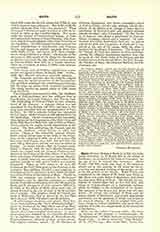

Haito (HATTO), Bishop of Basle; b. in 763, of a noble family of Swabia; d. March 17, 836, in the Abbey of Reichenau, on an island in the Lake of Constance. At the age of five he entered that monastery. Abbot Waldo (786-806) made him head of the monastic school, and in this capacity he did much for the instruction and classical training of the monks, as well as for the growth of the library. When Waldo was transferred to the Abbey of St. Denis, near Paris, in 806, Haito was made Abbot of Reichenau, and about the same time Bishop of Basle. He enjoyed the confidence of Charlemagne and in 811 was sent with others to Constantinople on a diplomatic mission, which he fulfilled to the satisfaction of his master. The interests of his diocese and abbey were not neglected. He rebuilt the cathedral of Basle and the abbey church of Reichenau, and issued appropriate instructions for the guidance of clergy and people in the ways of religion. In 823 he resigned both positions, owing to serious infirmities, and spent the remainder of his life as a simple monk in the monastery of Reichenau.
Haito was the author of several works. He wrote an account of his journey to Constantinople, the “Hodoeporicon”, of which, however, no trace has been found so far. In 824 he wrote the “Visio Wettini” (P.L., CV, 771 sqq.; Mon. Germ. Hist.: Poetae Lat.
Aev. Car., II, 267 sqq.), in which he relates the spiritual experiences of Wettin, president of the monastic school of Reichenau. The day before his death (November 4, 824) Wettin saw in a vision bad and good spirits; an angel took him through hell, purgatory, and heaven, and showed him the torments of the sinners and the joys of the saints. The book, which bears some resemblance to Dante’s “Divina Commedia”, was soon afterwards put into verse by Walafrid Strabo (Mon. Germ. Hist., loc. cit.). While Bishop of Basle, he issued a number of regulations in twenty-five chapters, known as the “Capitulare Haitonis” (P.L., CV, 763 sqq.; Mon. Germ. Leg., Sect. II, Capitular. Re. Franc., I, 363 sqq.; Mansi, XIV, 393 sqq.), in which he legislated on matters of diocesan discipline. The statutes were probably published in a synod.
FRANCIS J. SCHAEFER

